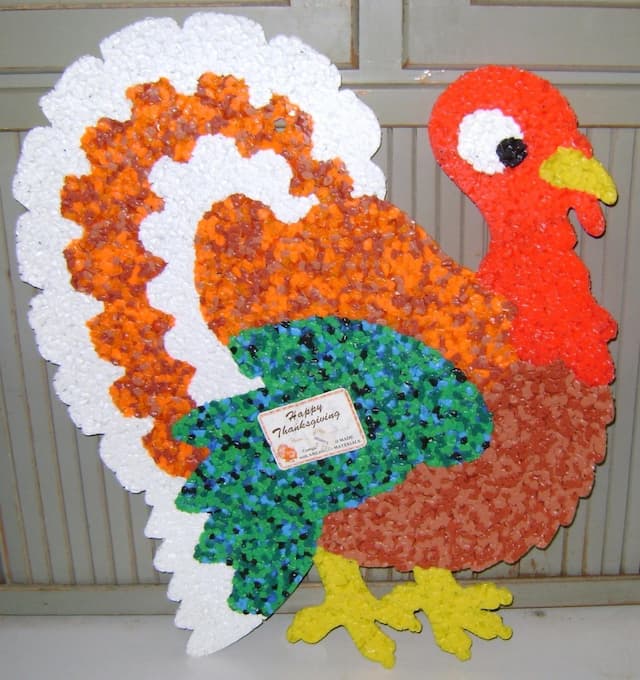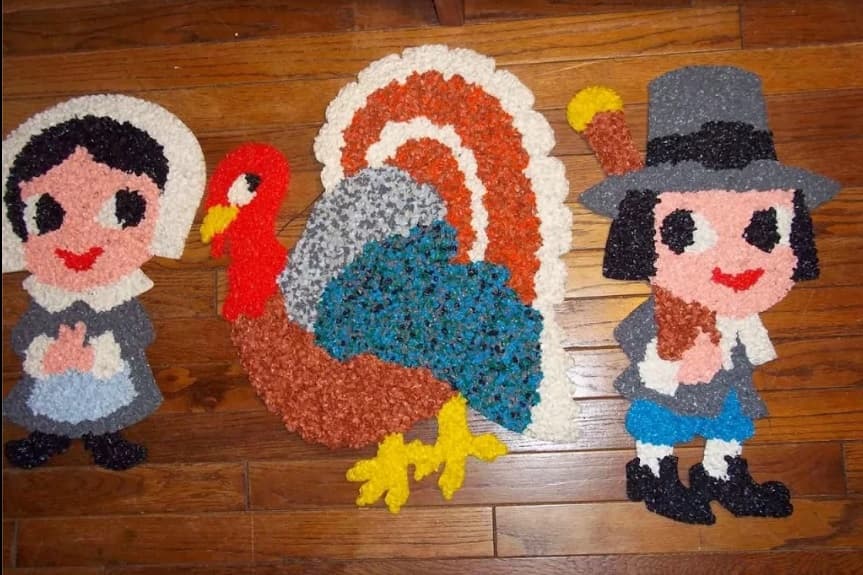First, how do you create decorations for melted plastic popcorn?
These tacky decorations—commonly known as “melted popcorn” because, well, that’s what they look like—were actually made of polyethylene. The Kage Company was founded by Hyman Gerstein in Manchester, Connecticut in the 1930s and began by making wooden clothes pins and doll furniture. Kage began producing plastic envelopes similar to those used to hold identification after the introduction of electric clothes dryers and more affordable plastic doll furniture made overseas.
The history of the decorations was related by the current president, William Hayes. When Gerstein’s daughter discovered a box of vibrant plastic chips left for her father by a salesman, she put the colorful parts together to form the outline of a small chicken. Her father baked her creation after placing it on a cookie sheet. To W.T. he brought it because he liked it so much. 25,000 of them were quickly ordered by Grant Co. executives in NYC.
melted popcorn decorations. When I was growing up, I can still picture these odd decorations hanging in classrooms. They were also on display in storefronts, and many people hung them in bay windows and on their front doors. I had no idea that these cool ornaments were being produced just outside my front door.
Please continue reading for more information.
Table of Contents
Significance To String Popcorn & Use It As A Christmas Tree Decoration
Jana, even though I am unaware of the history of stringing popcorn as a Christmas tree decoration, I would like to share my experience in that regard with you. On their Christmas tree, my grandparents would always hang popcorn, and I thought it looked lovely. I doubt I had two nickels to rub together when I got married for the first time years later. I wanted to have at least a small Christmas tree after winning some paint by number flat Christmas decorations. I cut off the top three feet of my neighbors’ Christmas tree because they were about to drive 300 miles home and were throwing out their tree, so that became my tree. I didn’t have enough money for popcorn, garland, lights, or even bulbs. However, I discovered a lot of styrofoam popcorn packaging in the trash boxes our neighbors had left out. I made a garland by threading countless Styrofoam peanuts onto my white thread using a needle. On the tree, it actually looked pretty good, almost like popcorn on a string. Not bad for a young man barely scraping by financially. I still have that garland, and on occasion I’ll hang it from our Christmas tree to remind myself of how fortunate I am in life and how poor I was in the beginning. Although most people might think those Styrofoam peanuts are ugly, I will always remember that garland.
Is It Harmful To Melt Plastic Bottles?
The question is utterly ambiguous. What is melting, how, where, and by whom?
Many plastic materials are recycled through melt processing and molding into new products, including bottles made of thermoplastic polymers like PE, PP, and PET. Therefore, there is no risk when using plastic bottles in melting processes carried out by trained skilled workers in an industrial setting or a well-ventilated lab/shop.
However, be careful if you intend to melt it in a pan (like butter when frying eggs) on a gas or electric stove in your kitchen with inadequate or no ventilation. The flammable fumes released when plastic melts pose high fire risks, as do the relatively toxic fumes’ high potential for intoxication. Furthermore, a lot of plastics are chemically unstable at melting temperatures, which causes them to oxidize and undergo significant degradation, leaving behind useless degraded and carbonized plastic materials.
How Do I Make Buttery Popcorn At Home?
The quick reply is to pop some popcorn, drizzle some melted butter over it, and stir.
Longer response: Invest in a 3-quart saucepan with a heavy bottom and a tight-fitting lid. Add one or two popcorn kernels and two tablespoons of vegetable oil. When you hear a kernel pop, cover the pan and continue heating it over high heat. Popcorn kernels amounting to 1/3 cup are then added to the pot, and the lid is then put back on. Listen to the corn pop as you gently shake the pot from side to side. Remove from heat when popping significantly slows down (take care not to burn the popcorn; it’s better to leave some kernels unpopped) and pour into a sizable serving bowl. Add 1/4 cup of the melted butter, then stir to combine.
Before spreading the butter on the popcorn, season it with salt or other seasonings if desired.

Plastic Melting Due To Gas?
Depending on what you mean when you say “gas.”
- By natural gas, do you mean? Then no.
- If you mean gasoline, then possibly. The plastic makes a difference. I have a plastic gas can that has held gasoline continuously for more than ten years and is still going strong. You can watch gasoline melt in front of your eyes by pouring it into a Styrofoam cup. Since each type of plastic is specifically created for a different application, they are not all the same and must each have a different set of characteristics. You can find a triangle with a number in it on the bottom of plastic containers, indicating the type of plastic.
- This is, at best, a vague question that sounds like it would be appropriate for an eight-year-old child. This is why I did flag it as being untrue. See more about How To Decorate An Unused Fireplace In Ideal Ways?
How Do You Pop Popcorn To Perfection?
How I make popcorn is as follows. Always use fresh kernels to avoid having a lot of unpopped ones when you’re finished.
A thick-bottomed pot should have two to three tablespoons of neutral oil in it. Before adding the kernels, let the pan heat up on medium. When the first kernel pops, add 1/2 cup of popcorn and a tablespoon of kosher salt, cover the pot, and continue cooking. When that occurs, start shaking the pot to prevent the popcorn from burning. When you no longer hear any popping sounds, continue shaking it back and forth over the heat. When the popping stops, remove it from the heat, pour it into a bowl, and devour.
Leave the popcorn in the bowl to cool, or do this. Add a cup of your preferred nuts. Pecans and cashews both taste good. You could even include a few tiny pretzels. Set the oven to 325°F. 4 tablespoons of butter, 1/4 cup light corn syrup, and 1 cup sugar are heated in a saucepan over medium heat. Five minutes of boiling are required after bringing it to a boil. 1 teaspoon each of baking soda and vanilla extract are added after it is removed from the heat. Stir to combine. Pour the syrup over the popcorn mix, toss to coat all the kernels and spread them on a buttered sheet pan. Stirring every ten minutes, bake it for 30 minutes, and then let it cool. Take a bite, breaking up any large lumps. See more about How To Make Paper Fan Decoration
Does Plastic Melt In Boiling Water?
In hot water, most plastics won’t melt. The temperature of boiling water is 100 degrees Celsius, which is not hot enough to melt plastic. Additionally, there are many different types of plastics—including polyethylene (PE), polypropylene (PE), polyvinyl chloride, and many others—that won’t melt at 100 degrees Celsius. Therefore, if you even attempt it, the plastic will only become hot rather than melting.
However, a few plastics, such as polylactic acid (PLA), melt at temperatures around 70 degrees Celsius. When you put it in boiling water, it will take an illogical shape.
The End
You can see how it’s made if you’ve ever had one, own one, or see one in person. Colored plastic fragments sort of melted together and clumped together as if they had been baked on a sheet. Simply enough for them to connect to one another, but not completely melted. The method is interesting to me, but I’m wondering if there’s a way to replicate it on a DIY basis. level. Or are the fumes and plastic simply too much?
Best wishes.


